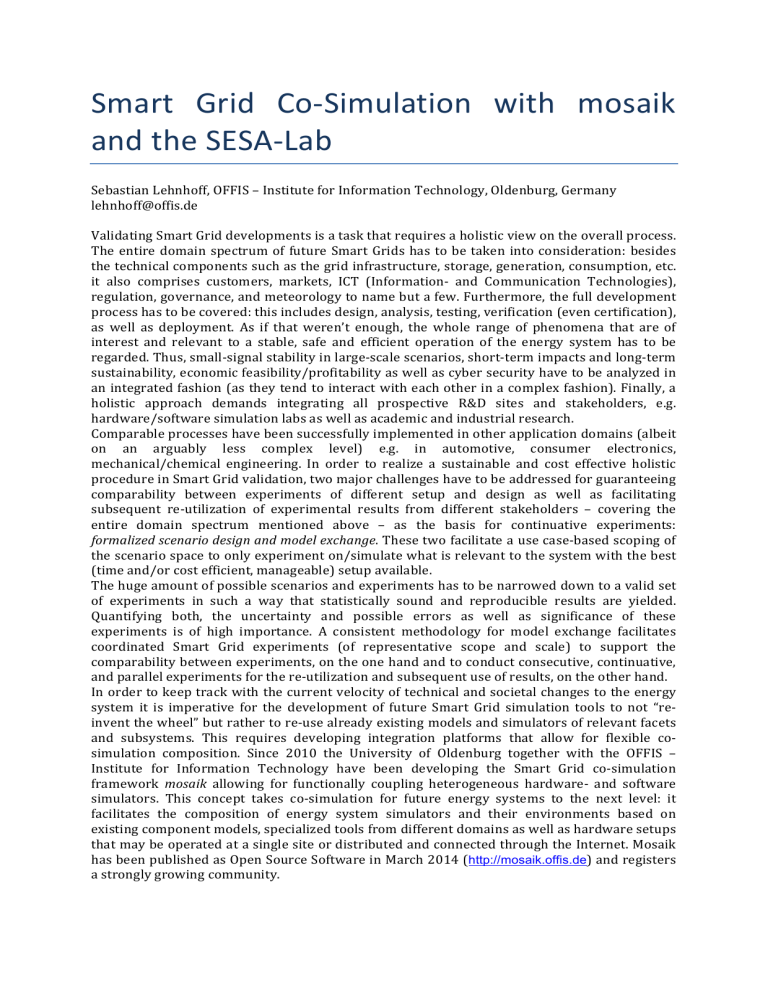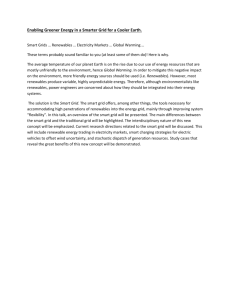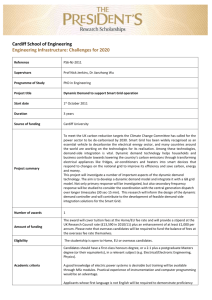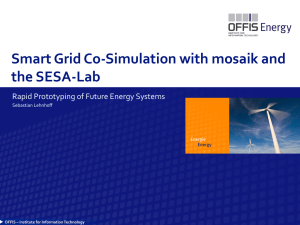Document 10483885

Smart Grid Co
-‐
Simulation with mosaik and the SESA
-‐ Lab
Sebastian Lehnhoff, OFFIS – Institute for Information Technology, Oldenburg, Germany lehnhoff@offis.de
Validating Smart Grid developments is a task that requires a holistic view on the overall process.
The entire domain spectrum of future Smart Grids has to be taken into consideration: besides the technical components such as the grid infrastructure, storage, generation, consumption, etc. it also comprises customers, markets, ICT (Information-‐ and Communication Technologies), regulation, governance, and meteorology to name but a few. Furthermore, the full development process has to be covered: this includes design, analysis, testing, verification (even certification), as well as deployment. As if that weren’t enough, the whole range of phenomena that are of interest and relevant to a stable, safe and efficient operation of the energy system has to be regarded. Thus, small-‐signal stability in large-‐scale scenarios, short-‐term impacts and long-‐term sustainability, economic feasibility/profitability as well as cyber security have to be analyzed in an integrated fashion (as they tend to interact with each other in a complex fashion). Finally, a holistic approach demands integrating all prospective R&D sites and stakeholders, e.g. hardware/software simulation labs as well as academic and industrial research.
Comparable processes have been successfully implemented in other application domains (albeit on an arguably less complex level) e.g. in automotive, consumer electronics, mechanical/chemical engineering. In order to realize a sustainable and cost effective holistic procedure in Smart Grid validation, two major challenges have to be addressed for guaranteeing comparability between experiments of different setup and design as well as facilitating subsequent re-‐utilization of experimental results from different stakeholders – covering the entire domain spectrum mentioned above – as the basis for continuative experiments: formalized scenario design and model exchange . These two facilitate a use case-‐based scoping of the scenario space to only experiment on/simulate what is relevant to the system with the best
(time and/or cost efficient, manageable) setup available.
The huge amount of possible scenarios and experiments has to be narrowed down to a valid set of experiments in such a way that statistically sound and reproducible results are yielded.
Quantifying both, the uncertainty and possible errors as well as significance of these experiments is of high importance. A consistent methodology for model exchange facilitates coordinated Smart Grid experiments (of representative scope and scale) to support the comparability between experiments, on the one hand and to conduct consecutive, continuative, and parallel experiments for the re-‐utilization and subsequent use of results, on the other hand.
In order to keep track with the current velocity of technical and societal changes to the energy system it is imperative for the development of future Smart Grid simulation tools to not “re-‐ invent the wheel” but rather to re-‐use already existing models and simulators of relevant facets and subsystems. This requires developing integration platforms that allow for flexible co-‐ simulation composition. Since 2010 the University of Oldenburg together with the OFFIS –
Institute for Information Technology have been developing the Smart Grid co-‐simulation framework mosaik allowing for functionally coupling heterogeneous hardware-‐ and software simulators. This concept takes co-‐simulation for future energy systems to the next level: it facilitates the composition of energy system simulators and their environments based on existing component models, specialized tools from different domains as well as hardware setups that may be operated at a single site or distributed and connected through the Internet. Mosaik has been published as Open Source Software in March 2014 ( http://mosaik.offis.de
) and registers a strongly growing community.





